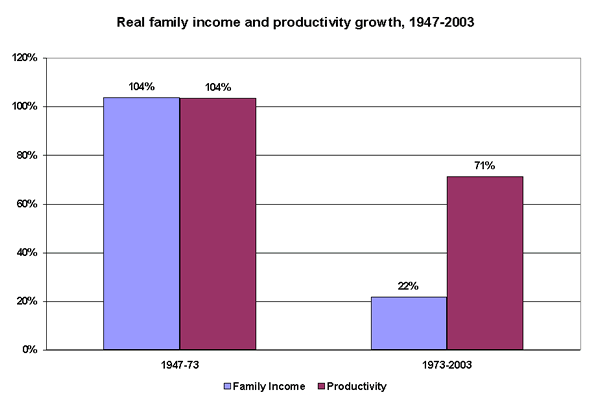See Snapshots Archive.
Snapshot for September 8, 2004
Productivity growth hasn’t resulted in increased family income in recent years
For the past three years, productivity has gone up while median family income has declined, undermining the living standards of the typical working family.
It is a common mantra among economists that productivity is the main determinant of living standards. Since productivity is, by definition, output per hour, as it rises, the U.S. workforce is able to create more output per hour of work. This productivity growth, in turn, implies more income to be distributed among households than during times of slower productivity growth.
However, as the below chart and recent history reveal, there is no guarantee that this added income will reach the typical (that is, median) family, especially in periods of high unemployment and rising inequality. Between 1947 and 1973—a golden age of growth for both variables—productivity and real median family income more than doubled, each growing by precisely the same amount. Over this era, there was no doubt that the typical family fully benefited from productivity growth. Starting in the mid-1970s, however, this virtuous relationship broke down.

From 1973 to 2003, median family income grew at less than one-third the rate of productivity. Relative to the earlier years, this was a period of growing income inequality, which served as a wedge between productivity and the living standards of the median family. Other factors were at play as well, including changes in family size and type, but the main factor was the wedge of inequality.1 That is, while faster productivity growth led to a larger economic pie, growing inequality meant that slices were divided up such that some income classes—particularly those at the top of the income scale—claimed most of the income growth.
These conditions have certainly been in play over this business cycle as well, as productivity grew each year from 2000 to 2003, increasing by a total 12%. Meanwhile, real median family income fell each of these years, declining by an overall 3%.
This week’s Snapshot was written by EPI Economist Jared Bernstein.
1. Another factor behind the gap is the different growth rates of price deflators, with the output deflator growing more slowing than the consumption deflator.
